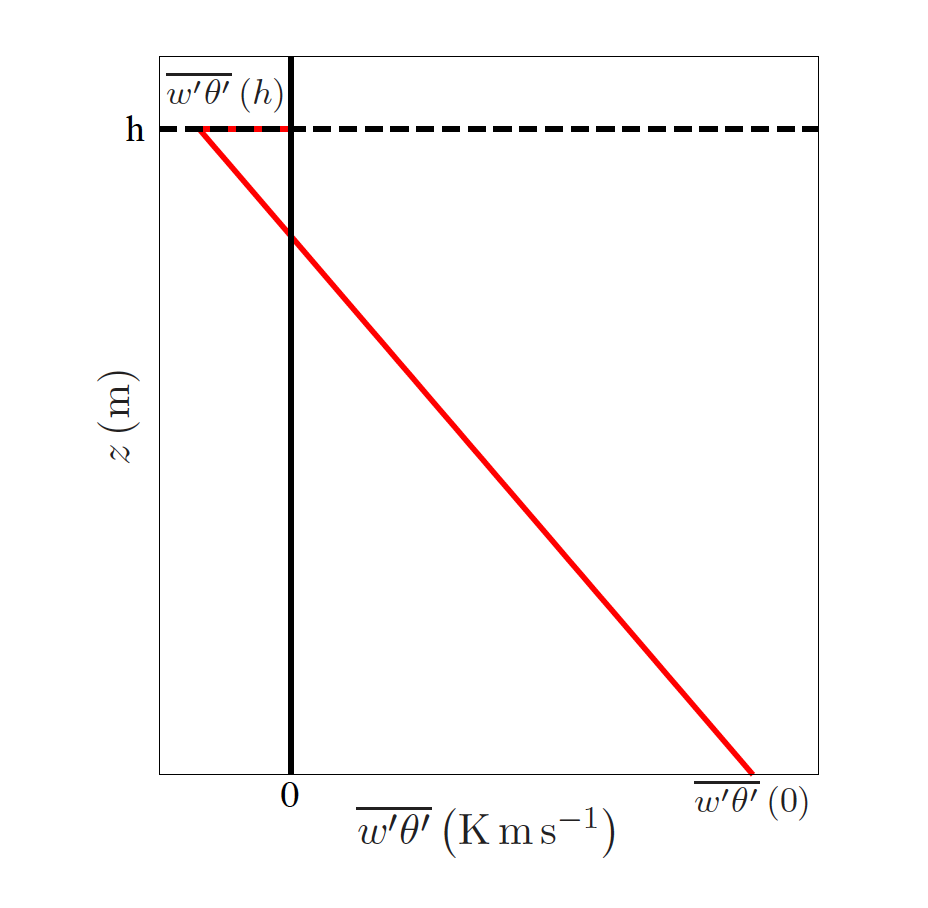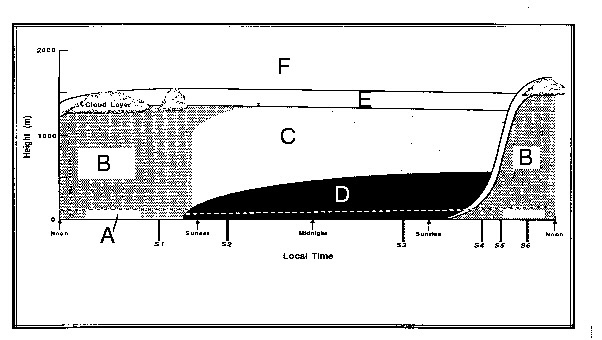18. Exercises week 2#
\(\def\pafg#1#2{\dfrac{\partial #1}{\partial #2}}\) \(\def\afg#1#2{\dfrac{{\rm d} #1}{{\rm d} #2}}\)
18.1. #
Given a surface specific humidity of 15 g/kg, a surface pressure of 1003 hPa and a temperature described by \( T = 4x + zy ~(C) \) calculate the potential temperature and the virtual potential temperature at the point (5, 1, 2) and at the pressure 850 hPa (\(R_d=287\ J\ Kg^{-1}\ K^{-1}, c_p=1004\ J\ Kg^{-1}\ K^{-1}\)).
Hint
Answer
We know:
Substituting these numbers results in:
18.2. #
During a measurement campaign the following vertical profile of potential temperature was measured at 14 UTC (see Fig. 18.1).
a) Name each of the layers indicated in the figures with the letters A, B, C and D
Answer
A. Surface layer
B. Mixed layer
C. Entrainment zone/layer
D. Free troposphere
b) Find the vertical gradient of temperature
for each of the layers above mentioned.
Answer
It depends on how you draw the schematic lines.A. \(\rm \frac{-1.5 K}{300 m} = -5\ K\ km^{-1}\)
B. \(\rm \frac{0 K}{1100 m} = 0\ K\ km^{-1}\)
C. \(\rm \frac{8 K}{350 m} = 23\ K\ km^{-1}\)
D. \(\rm \frac{0.75 K}{400 m} = 1.9\ K\ km^{-1}\)
c) Indicate for each layer whether it is stable, neutral or unstable and whether it is turbulent or laminar.
Answer
A. Unstable and turbulent
B. Neutral and turbulent
C. Stable, but turbulent
D. Stable and laminar

Fig. 18.1 Vertical profile of potential temperature measured by a radiosonde at 14 UTC.#
18.3. #
The Navier-Stokes equation for the horizontal, instantaneous velocity is
We can make this equation dimensionless by using the following (variables indicated with a \(*\) are dimensionless):
\(u_{i}^*= \dfrac{u_i}{\cal U}\)
\(x_{j}^*= \dfrac{x_j}{\cal L}\)
\(p^*= \dfrac{p}{\rho\, \cal U\rm^2}\)
\(\cal L\) and \(\cal U\) represent respectively the scaling height and scaling velocity.
a) Derive the dimensionless time variable (t*) by using t, \({\cal U}\) and \({\cal L}\)
Answer
The unit of time is seconds. To obtain something with the same units from \({\cal U}\) and \({\cal L}\), one can use \( \dfrac{\cal L}{\cal U}\) Therefore \(t^*= t\dfrac{\cal U}{\cal L}\)
b) Using the scales \(\cal U\), \(\cal L\), deduce the dimensionless form of the Navier Stokes equation.
Answer
Substituting this in the Navier Stokes equations results in
This equation can be multiplied by \(\frac{\cal L}{\cal U\rm^2}\) to obtain the dimensionless form:
This can also be expressed with the Reynold’s number, \({\rm Re} = \frac{\cal U L}{\nu}\) and Rossby number \({\rm Ro} = \frac{\cal U}{f \cal L}\):
c) Typical length scales in the ABL are \(\cal U\)= 1 \(\rm{m\ s^{-1}}\) and \(\cal L\)=1000 m. Are the Coriolis rotational term and the viscous term relevant in the ABL?
(\(f=10^{-4}\ \rm{s^{-1}}\), \(\nu_{air}=1.5 \cdot 10^{-5}\ \rm{m^2\ s^{-1}}\))
Answer
Contribution of Coriolis force with respect to the other terms: \(f^* = f \frac{\cal L}{\cal U} = 0.1 = 10~\%\). This contribution is weak, but significant. Contribution of viscosity: \({\rm Re} = \frac{\cal U L}{\nu} = 6.7 \cdot 10^7\), so \(\frac{1}{\rm Re} \to 0\). This contribution is not significant. Consequently, this term can be neglected.
18.4. #
The thermodynamic equation reads
a) Find the equation for the averaged potential temperature \(\overline{\theta}\).
Answer
Because of incompressibility, \(\pafg{u_j}{x_j}=0\), and therefore also \(\pafg{\overline{u_j}}{x_j}=\pafg{u_j'}{x_j} =0\). Therefore
This is the flux form; after Reynolds averaging Equation (18.1), the divergence of a turbulent flux is obtained. Using this relation, the total thermodynamic equation reads
b) Suppose that \(\overline{w'\theta'}~=~a - bz\) where \(a=0.3\ \rm{K\ m\ s^{-1}}\) and \(b=3 \cdot 10^{-4}\ \rm{K\ s^{-1}}\). How long will it take the ABL to warm up 0.54 K?
Hint
From the \(\overline{\theta}\) equation neglect subsidence, radiation and latent heat releases and assume horizontal homogeneity.
Answer
Since there are no clouds, no latent heat release is present: \(\overline{E}=0\).
The impact of radiation is relatively small during day: \(\frac{1}{\rho c_p} \pafg{\overline{Q_j}}{x_j} \approx 0\).
Due to the high turbulent nature of the atmospheric boundary layer, the viscous term can be neglected as well: \(\nu_{\theta}\pafg{^2\overline{\theta}}{{x_j}^2} \approx 0\).
We assume horizontal homogeneity, so \(x\) and \(y\) derivatives of Reynold’s averaged variables are equal to 0.
Without subsidence, the mean vertical wind velocity, \(\overline{w}\), is equal to 0 as well.
Finally, the equation results in
Since \(\pafg{\overline{w'\theta'}}{z} = - b\), \(\pafg{\overline{\theta}}{t} = 3 \cdot 10^{-4}\rm\,K\,s^{-1}\). The time needed is equal to \(\frac{0.54\rm\,K}{3 \cdot 10^{-4}\rm\,K\,s^{-1}} = 1800\,{\rm s} = \frac{1}{2}\,{\rm hr}\).
c) In a pseudo-stationary state, the vertical profile of the averaged potential temperature is constant with time, i.e. \(\left(\pafg{}{t}\right)\ \left(\pafg{\overline \theta}{z}\right) \approx 0\). Calculate the heat flux profile \(\overline {w'\theta'}(z)\) for the following boundary condition values of the heat flux at \(z=0~~\) \(\overline {w'\theta'}(0)\) and at \(z=h~~\) \(\overline {w'\theta'}(h)\).
Hint
Use the same assumptions as in 3b.
Answer
The governing equation is
By taking the derivative to \(z\) of this equation, we obtain
The left hand side can be rewritten:
This is known as the quasi-steady approximation. It holds true under convective conditions and states that the gradient of potential temperature does not change on time.
Equations (18.2) and (18.3) show that
This results in
Using the boundary conditions:
\(\overline{w'\theta'} = \overline{w'\theta'}(0) + \left( \overline{w'\theta'}(h) - \overline{w'\theta'}(0) \right)\frac{z}{h}\)
In the figure, a visual representation is shown.

18.5. #
The Bowen ratio is defined as the ratio of the heat flux to the moisture flux (\(B=H/LE\)). Using K-theory to parameterize the fluxes and assuming that \(K_h=K_q\), calculate the Bowen ratio from the following measurements at 10 meters (\(\theta=300\ \rm{K}\), \(q = 10\ \rm{g\ kg^{-1}}\)) and at 2 m (\(\theta=302\ \rm{K}\), \(q = 12\ \rm{g\ kg^{-1}}\)).
(\(L=2.5 \cdot 10^{6}\ \rm{J\ kg^{-1}}\) and \(c_p=1004\ \rm{J\ kg^{-1}\ K^{-1}}\))
Answer
We know
which can be related to gradients using the first-order closure,
Therefore,
All constants are known and from measurements follow \(\pafg{\overline{\theta}}{z} = \frac{-2\,{\rm K}}{8\,{\rm m}}\) and \(\pafg{\overline{q}}{z} = \frac{-2\cdot 10^{-3} \,{\rm kg\ kg^{-1}}}{8\,{\rm m}}\).
This results in B=0.4.
18.6. #
Given the following draw of the evolution of the atmospheric Boundary Layer, fill in the table with the most appropriate labels (some examples have been already inserted) .

Region |
Name |
Lapse rate |
Heat Flux |
Static stability |
Turbulent? |
|---|---|---|---|---|---|
A |
Superadiabatic |
||||
B |
Mixed Layer |
||||
C |
0 |
||||
D |
Sporadic |
||||
E |
Subadiabatic |
Stable |
|||
F |
Sporadic |
Answer
Region |
Name |
Lapse rate |
Heat Flux |
Static stability |
Turbulent? |
|---|---|---|---|---|---|
A |
Surface Layer |
Superadiabatic |
>0 |
Unstable |
Yes |
B |
Mixed Layer |
Adiabatic |
\(\begin{cases} >0 \\ <0 \end{cases} \) |
Neutral |
Yes |
C |
Residual layer |
Adiabatic |
0 |
Neutral |
Sporadic |
D |
Nocturnal boundary layer |
Subadiabatic |
<0 |
Stable |
Sporadic |
E |
Capping inversion |
Subadiabatic |
0 |
Stable |
Sporadic |
F |
Free atmosphere |
Subadiabatic |
0 |
Stable |
Sporadic |
Superadiabatic: The temperature decreases more with height compared to the case of adiabatic cooling.
Subadiabatic: The temperature decreases less with height compared to the case of adiabatic cooling.
In the mixed layer, the heat flux decreases with height. It’s positive in the lower \(\frac{5}{6}\) part of the boundary layer and negative in the rest.
In the residual layer, capping inversion, and in the nocturnal boundary layer, turbulence is generated by shear. In the free troposphere as well, but less frequent due to the stronger stability.
